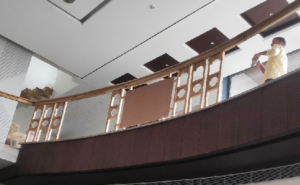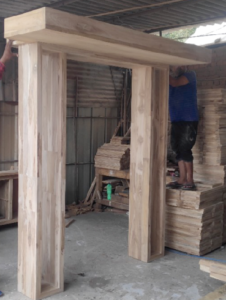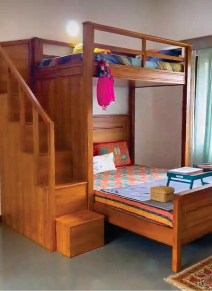
Promoting preservative treatment and seasoning – Rajneesh Tyagi
- September 9, 2023
- 0
Promoting preservative treatment and seasoning will increase wood’s utility as well as greenery
We plant a tree and save another, or let’s say, we extend the life of timber we use after cutting. This way, we will reap double benefits.
Benefits of seasoning wood?
Seasoning of wood is essential in every way. It enhances the life and usefulness of wood manifolds. This will further increase the use of wood and enthusiasm among people for tree planting. This will naturally invigorate the environmental conservation campaign initiated by the government. Although the tree planting campaign is already initiated, proper and intelligent use of wood is equally important. Only then a proper balance can be maintained. We plant a tree and save another, or let’s say, we extend the life of timber we use after cutting. This way, we will reap double benefits.
For this wood treatment to eliminate pests should be legally mandatory along with seasoning. Wherever wood is used, it should be mandatorily seasoned and treated before use. Such wood will be less prone to decay. Any natural pests within the wood, will also die. The temperature during seasoning reaches more than 60 degrees Celsius. As soon as the temperature reaches around 50 degrees Celsius, the pests die. The moisture content of the wood will be reduced to nil. This will almost eliminate the chances of the shrinking and warping in wood.

Definition of Wood Seasoning:
Drying of Wood under controlled atmospheric conditions is called the Wood Seasoning. This controlled drying of Wood minimizes the risks of warping, cracking, and shrinking, making it suitable for manufacturing high-quality furniture.
Importance of Wood Seasoning in Furniture Export:
1. Stability and Structural Integrity: Proper seasoning minimizes the moisture content in wood, reducing the likelihood of warping, splitting, or other forms of structural damage in service or fluctuating environmental conditions.
2. Dimensional Accuracy: Seasoned wood has comparatively stable dimensions, ensuring the furniture in its intended shape and measurements are accurate.
In foreign countries, especially in forest department of Canada, there is a rule that if a tree is harvested, six saplings need to be planted in its place. The person responsible for cutting the tree will have to ensure that these six saplings thrive.
3. Improved Workability: Controlled drying reduces the wood’s moisture content, making it easier to work with during the manufacturing process, resulting in precise cuts, joinery, and finishing techniques.
Prevents Insect Infestation: Seasoning eliminates insects and their eggs that may infest the wood, protecting the furniture during transportation and storage.
 Types of Wood Seasoning:
Types of Wood Seasoning:
1. Air Seasoning: In this age old traditional method, wood is stacked in open-air conditions, allowing natural evaporation of moisture to reduce moisture content. Air seasoning is cost-effective but relatively time-consuming.
2. Artificial Seasoning: The wood is seasoned by Kiln, Chemical or Vacuum type processes.
2.1. Kiln Seasoning: Kiln drying accelerates the moisture extraction process by placing wood in specially designed chambers. This method allows for precise control over temperature, humidity, and drying time, resulting in faster and more consistent seasoning.
2.2. Vacuum Seasoning: Vacuum drying involves placing wood in a sealed chamber, reducing the atmospheric pressure, and accelerating the evaporation process. This method allows for faster drying while preserving the natural color and quality of the wood.
2.3. Artificial and Chemical Seasoning: Artificial seasoning involves using specialized equipment to control temperature, humidity, and air circulation. Chemical seasoning utilizes chemicals to extract moisture and accelerate drying, but it is less commonly used due to environmental concerns.
Wood seasoning proves to be a vital step in furniture export, ensuring the preservation, quality, and stability of wooden products. Implementing proper wood seasoning methods, such as air drying, kiln drying, vacuum drying, or artificial seasoning, can significantly impact the success and reputation of furniture exporters. By understanding the benefits and types of wood seasoning, industry professionals can make informed decisions to deliver exceptional furniture to international markets.
Private companies use various energy-saving techniques, which benefits them even after paying royalties to research institutes.
 Does seasoning wood increase its lifespan?
Does seasoning wood increase its lifespan?
As soon as wood is seasoned and its moisture is removed, its lifespan is extended. The chances of damage to this wood is reduced exceptionally, and it can be used for an extended period. Using seasoned wood in furniture enhances its stability and utility, allowing it to maintain its beauty and usefulness over a long time. An example of seasoned and unseasoned wood can be seen in doors. Unseasoned wood used in doors tends to swell during summer and shrinks during cold, resulting in poor appearance and functionality. Properly seasoned wood, on the other hand, prevents such issues. It doesn’t attract mold, and problem with borer is also eliminated.
Wood should undergo seasoning before being used anywhere, but relying solely on legislation will not suffice. A comprehensive awareness campaign is necessary. The availability of seasoning facilities should be ensured in every city and village where sawmill exists.
Do seasoning plants will be operated by saw millers?
Small saw millers might not have the financial capacity to establish seasoning plants. Even if it becomes legally mandatory, corruption might hinder the system. Instead, the government or the forest department should establish the plants themselves.
Once the wood is processed through sawmills, seasoning should be made obligatory. A certificate should be issued after seasoning from the seasoning plants.
The government should also ensure that only seasoned wood is used in government buildings. This would raise awareness not only among government officials but also among the general public.
How general public be aware about seasoning?
The government will have to take the initiative at this point. Apart from creating appropriate legislation for wood seasoning an awareness campaign should be initiated on a larger scale. This campaign should emphasize the importance of proper seasoning and pest control before using wood.
 Generally, constructing a single house requires around 150-200 cft of wood. Plants should be set up in all cities according to this calculation.
Generally, constructing a single house requires around 150-200 cft of wood. Plants should be set up in all cities according to this calculation.
But, the availability of this seasoning facility should be made accessible to the general public. Either the government establish seasoning plants or provide loans to interested entrepreneurs, including sawmill owners, to set up such plants. To encourage initially, the government should provide subsidies. Hopefully, with the government’s encouragement, awareness will rise, and people’s trust in seasoned wood will grow, along with an increase in tree planting efforts.
How will tree planting increase?
In our area, a fee of 100 rupees as NSC per tree is charged as an environmental fee when a tree, other than agro forestry plants, is harvested. In foreign countries, especially in forest department of Canada, there is a rule that if a tree is harvested, six saplings need to be planted in its place. The person responsible for cutting the tree will have to ensure that these six saplings thrive. This ensures that after a certain period, there will be six trees in the same area.
This is an exemplary step for environmental balance and the continuous availability of wood. If a similar practice of planting saplings and nurturing them, until they grow into trees, is implemented here, it would greatly benefit the environment. We need such kind of awareness.
 Do research institutions have a role to play?
Do research institutions have a role to play?
In foreign countries, especially in Canada, research institutions are self-sufficient in terms of revenue, and they even repay their share of profits to the government. Private companies use various energy-saving techniques, which benefits them even after paying royalties to research institutes. Our research institutions should also tailor their research based on the needs of industries.
Indian entrepreneurs are intelligent and hardworking. However, we tend to waste a significant part of our business life learning things individually and in isolation. For various reason, there is very little collaboration between research institutions and entrepreneurs.
Does everyone benefit from government-run seasoning plants?
There are several government-run seasoning plants in Saharanpur, as it is a hub of furniture industry. However, the issue is that these seasoning plants are large in size. Perhaps these plants were established in view of large exporters. Therefore, small saw mill owners or job workers (carpenter) get relatively less benefit from this facility. They have to wait as they don’t have sufficient quantity of wood.
Generally, constructing a single house requires around 150-200 cft of wood. Plants should be set up in all cities according to this calculation. Only then small and large stakeholders, as well as the general public, can reap its extensive benefits. To promote and propagate seasoning plants, it’s essential to make the process easy and accessible.































































